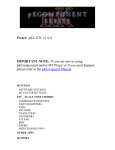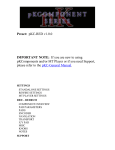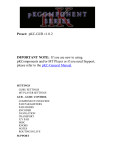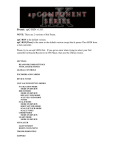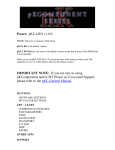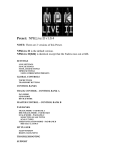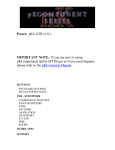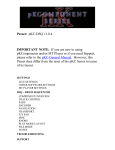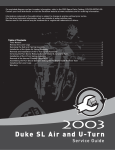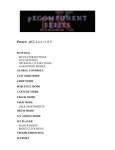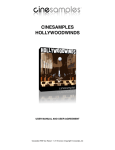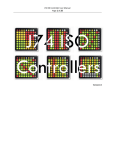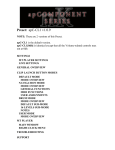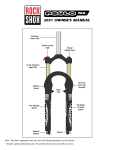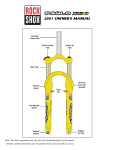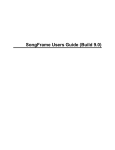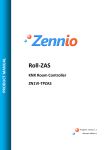Download nativeKONTROL pKC
Transcript
Preset: pKC-SCL v1.0.2 IMPORTANT NOTE: If you are new to using pKComponents and/or MT Player or if you need Support, please refer to the pKC-General Manual. SETTINGS SOFTWARE SETTINGS MT PLAYER SETTINGS SCL – SCALE COMPONENT OVERVIEW PAD PARAMETERS PADS ENCODER NAVIGATION TRANSPORT X/Y PAD MISC KNOBS DRUM MAP COMPATIBILITY SCALE TYPES MIDI CHANNEL INFO OTHER APPS SUPPORT SETTINGS SOFTWARE SETTINGS In order to use this Component’s main controls with your software, you need to set the software up to receive MIDI from “From MT Player 3”. For example, with Ableton Live, you’d go to Option-PreferencesMIDI/Sync and turn the Track switch on for “From MT Player 3”. With Reason, you’d go to Edit-Preferences-Control Surfaces and Keyboards. You’d click the Add button, select “<Other>” from the Manufacturer list and select “MIDI Keyboard w Controls” from the Model list. For the In Port, you’d select “From MT Player 3”. In order to use this Component’s Transport controls with your software, you need to set up the Mackie Control as a control surface in your software. For the control surface’s input, you’ll select “From MT Player 1”. For the control surface’s output, you’ll select “To MT Player 1”. MT PLAYER SETTINGS The first time you use your padKONTROL in MT Player, you will need to setup the padKONTROL’s ports. You are prompted to do this as soon as a Preset is selected in MT Player. However, if you bypass those prompts, you can access the settings by right-clicking on MT Player and selecting MIDI Settings. 1. From the Port Name menu, select “IN: padKONTROL 1 PORT A”. 2. From the MIDI In port menu, select your padKONTROL’s PORT A and click OK. 3. Go back into MIDI Settings. 4. From the Port Name menu, select “OUT: padKONTROL 1 CTRL”. 5. From the MIDI Out port menu, select your padKONTROL’s CTRL PORT and click OK. 6. Click the Restart button. You can learn more about MT Player in the pKC General Manual. 1 SCL – SCALE COMPONENT OVERVIEW This Component provides immediate access to 40 Scale Types for any of the 12 Root Notes, transposable over –4 / +4 Octaves. It also provides Add Note functions for creating chords/harmonies and playing multiple Octaves on-the-fly. PAD PARAMETERS ADD NOTE 1 – Press this Button and the Display will show the current setting of Add Note 1 (-24 / +24 semitones). A setting of 0 = Add Note 1 Off. Hold this Button down and use the Encoder to adjust the setting for Add Note 1. OFF 1 – Turns Add Note 1 Off (sets it to 0). ADD NOTE 2 – Same as Add Note 1. OFF 2 – Same as Add Note 1. FIXED VELO – Turns off the velocity response of the Pads. NOTE: You cannot adjust/turn off Add Note 1 or 2 while any Pads are held. 2 PADS The Pads will play the selected Scale. ENCODER ROOT – Selects the Root Note (C – B) of the Scale. SCALE – Selects the Scale Type (see Scale Types section). NAVIGATION OCT -/+ – Move down or up Octaves. SUS – Sustain the currently held Note(s). TRANSPORT PLAY/STOP – Play/Stop playback. UNDO/REDO – Undo/Redo. REC – Toggle Arrangement Record. CLIP REC – Use this to record perfectly cut Clips (Audio or MIDI) at the current Global Quantization value. For example, if Global Quantization is set to 2 bars, this will record a perfect 2-bar clip. This function is intended for the creation of new Clips, so Overdub should be turned off when using it. REW/FFW – Rewind/Fast-Forward. PREV M/NEXT M – Jump to Previous/Next Marker. LOOP – Toggle Arrangement Loop. CLIP/TRK – Toggle between Clip and Track Views. NOTE 1: If a Pedal is connected, it will sustain the currently held Note(s). NOTE 2: If you’re using an application other than Ableton Live, please see the Other Apps section. 3 X/Y PAD Two types of X/Y Pad functions are available: Pb/Mod (the default) and Slide. PB/MOD – X-axis will control Pitch Bend and the Y-axis will control the Mod Wheel. SLIDE – X-axis is split into 16 zones. Each zone triggers one of the Notes in the assigned Scale. The Y-axis controls the velocity of the Notes, unless Fixed Velocity is turned on. The Y-axis can also control Mod Wheel and/or Aftertouch. MISC X/Y HOLD – Hold the current value of X/Y. PB/AT ON/OFF – With Pb/Mod, this will turn Pitch Bend on/off for the Xaxis. With Slide, this will turn Channel Aftertouch on/off. PB/MOD – This will select the Pb/Mod function. MOD ON/OFF – This will turn Mod Wheel on/off for the Y-axis. SLIDE – This will select the Slide function. NOTE: When you press Shift, the Pb/Mod or Slide Button LED will light to indicate which function type is assigned to the X/Y Pad. KNOBS The Knobs are used to control 8 instrument-level parameters. KNOB 1 ASGN – Press this Button and the Display will show the parameter that is assigned to Knob 1. Hold this Button down and use the Encoder to select which parameter is assigned to Knob 1. KNOB 2 ASGN – Same as Knob 1 Asgn. KNOB PARAMETERS Aft – Channel Aftertouch PB – Pitch Bend Mod – Mod wheel Vol – Volume (CC7) Cut – Filter cutoff frequency (CC74) 4 Rez – Filter resonance (CC71) Att – Amp attack (CC73) Rel – Amp release (CC72) DRUM MAP COMPATIBILITY This Component is compatible with the drum maps for a variety of software and hardware instruments. Here are a few examples of drum maps along with the necessary Scale settings. GM Drum Map – Any Chromatic scale. Reason ReDrum – Root=C / Scale=Chromatic / Octave= -1 Live Impulse – Root=C / Scale=Major / Octave= 1 SCALE TYPES DISPLAY SCALE NAME DISPLAY SCALE NAME ALG ARB AUG BAL BLU BYZ CHI CHR DIM DOR 8TS ENI HMI HIN HIR HGY HMJ JAP JAV JEM KUM LC1 LC2 LDN MAJ MMI MIN MLD NEO OCT ORN PMJ PMI PNT PER PHG PUR ROM TOD 0TN Algerian Arabian B Augmented Balinese Blues Byzantine Chinese Chromatic Diminished Dorian 8-Tone Spanish Enigmatic Harmonic Minor Hindu Hirajoshi HungarianGypsy Hungarian Major Japanese B Javanese Jewish Magen Kumoi Locrian Locrian 2 Lydian Major Melodic Minor Minor Mixolydian Neopolitan Octatonic HW Oriental B Pentatonic Major Pentatonic Minor Pentatonic Neutral Persian Phrygian Purvi Roumanian Todi Whole Tone 5 MIDI CHANNEL INFO By default, all the controls in this Component are sent out on MIDI Channel 1. When you press Shift, Pad 1 will light up to indicate this. You can change the channel by holding down Shift and pressing one of the 16 pads, each of which corresponds to a MIDI Channel. For example, to use MIDI Channel 6, you’d press Shift+Pad 6. OTHER APPS When using this Component with applications other than Ableton Live, the Transport section will work slightly differently. Play, Stop, Rec, FFW and REW should all work as described in the Transport section. The other functions may work, but may perform different functions than what is described in the Transport section. The Clip Rec function will definitely not work, that is a Live-specific function. SUPPORT Email: [email protected] Forum: Beatwise Network Videos: Stray's YouTube Channel Copyright 2013 nativeKONTROL. All rights reserved. This document, as well as the software described in it, is provided under license and may be used or copied only in accordance with the terms of this license. The content of this document is furnished for informational use only, is subject to change without notice, and should not be construed as a commitment by nativeKONTROL. Every effort has been made to ensure that the information in this document is accurate. nativeKONTROL assumes no responsibility or liability for any errors or inaccuracies that may appear in this document. All product and company names mentioned in this document, as well as the software it describes, are trademarks or registered trademarks of their respective owners. This software is solely endorsed and supported by nativeKONTROL 6







